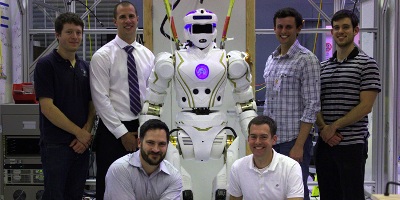Dec 13 2013
The advanced humanoid robot, Valkyrie, unveiled by NASA Johnson Space Center (JSC) moves and walks, thanks to Texas A&M University’s Dr. Aaron Ames.
 Ames and Team With Val
Ames and Team With Val
Ames, assistant professor in the Department of Mechanical Engineering, and his research team in the A&M Bipedal Engineering Robotics (AMBER) Lab are responsible for Valkyrie’s locomotion, mobility and full-body coordination. Ames also has joint appointments in the Department of Electrical and Computer Engineering and the Department of Computer Science and Engineering.
The methods used to achieve these behaviors were pioneered by the AMBER Lab NASA group: graduate students Eric Cousineau, Jordan Lack, Matthew Powell, Ryan Sinnet, and James Holley, and research engineer Dr. Benjamin Morris, all working under Ames' guidance. This group has spent the past year and a half practically living at NASA JSC in order to devote all their efforts to this project.
Valkyrie, representing the NASA JSC team, and 16 other teams from around the world will participate in the DARPA Robotics Challenge (DRC) Trials at Florida’sHomestead Miami Speedway Dec. 20-21. The trials will provide a baseline on the current state of robotics and determine which teams will continue on to the DRC finals in 2014 with continued DARPA funding. Competing in the 2014 finals will lead to one team winning a $2 million prize.
Developed at the Johnson Space Center with researchers from Texas A&M and the University of Texas at Austin, with funding from the State of Texas, Valkyrie is a 6.2-foot, 275-pound hulk designed to walk untethered, and pick up and manipulate objects — skills required for the DARPA challenge.
With its 44 degrees of freedom, or axes of rotation, in its joints Valkyrie is a relatively flexible robot in terms of movement. Valkyrie is powered by a battery stored in a backpack that can provide it with about an hour of battery life. The robot’s sensors include sonar and LIDAR, and head, arm, abdomen and leg cameras so its operators can see what the robot is doing from multiple angles.
DARPA said that robots are just beginning to demonstrate their value to defense, national security and society as a whole, but the field of robotics needs to be catalyzed. Impressive as they are, most robots today are either limited to pristine and precisely controlled settings like factories and research labs, employed in simple, repetitive tasks, or used as mechanical stand-ins for humans who have to direct their every move.
These kinds of robots cannot deal well with unpredictability and unstructured environments. Until they can, society won’t realize the benefits that more advanced robots might provide. The DARPA Robotics Challenge leverages DARPA’s past investments in robotics and applies the agency’s unique approach to innovation toward one goal: developing robots capable of assisting humans in natural and man-made disaster zones. The December trials will give DARPA a baseline on the current state of robotics and determine which teams will continue to receive funding to expand on their potential.
The agency said it expects these robots are going to move slowly through the tasks. Like 1-year-old children beginning to walk and interact with the world, there will be stumbles and falls. But the DRC trials are an opportunity to witness the beginning of an historic transformation in robotics.
Ames won’t be the only Texas A&M robotics expert at the DRC trials. Dr. Robin Murphy, a pioneer in the field of rescue robotics and the Raytheon Professor in the Department of Computer Science and Engineering, and her students are bringing the RESPOND-R mobile lab loaded with rescue robots to participate in the exposition at the challenge trials.
The RESPOND-R mobile lab is part of a $2 million National Science Foundation Major Research Instrument grant to create a mobile, distributed test instrument capable of capturing data about robots, sensors, wireless networks, and human performance during disasters. The lab was the brainchild of Murphy, Ames, Dr. Dezhen Song, Dr. Ricardo Gutierrez-Osuna and Dr. Radu Stoleru.
Murphy said the group will show off the rescue robots to the public, especially members of the FIRST Lego League, a robotics program for 9- to 16-year-olds to get children excited about science and technology.
The Center for Emergency Informatics and the Center for Robot-Assisted Search and Rescue, both directed by Murphy and part of the Texas A&M Engineering Experiment Station, have been working with students all over the country and have connected international experts with teams.
“We plan to host a ‘tweet if you see us on the road’ campaign and have a couple of flash-mob demos at museums in Florida,” Murphy said. “We will have robots on display and more set up for kids to get hands-on time with.”